How To Fix A Bike Pump Hose
When it comes to repairing and maintaining your bike—with brakes, derailleurs, cables, and more—the checklist can seem endless. But there's one other crucial, though often overlooked, element that's arguably just as important to care for in order to keep your bike rolling: your floor pump.
Sure, your floor pump will kick the bucket eventually. But if a part breaks or isn't working quite as well as it used to, chances are you'll be able to fix it.
Join Bicycling now for the latest advice and tips!
"In my time in shops, I have given many pumps a second life," says Bicycling's resident mechanic Joël Nankman, who's wrenched professionally for 13 years. When a customer would come into the shop to buy a new bike pump, Nankman says that sometimes he could simply fix their old one instead.
Many of the repairs and maintenance measures are easy enough for most people to do on their own. So when you find yourself with a floor pump that's failing, don't toss it just yet—you might just be able to return it to its former glory. (Plus, it's the eco-friendly thing to do, right?)
Below, Nankman offers his tips on how to repair and maintain your bike floor pump.
Preventative Maintenance for Floor Pumps
To start, there are some things you can do to help prevent your floor pump from breaking in the first place—namely, storing it correctly. Here's what Nankman recommends:
Keep It Dry
You wouldn't leave your bike out in the rain (or maybe you would, but here's why you shouldn't), and the same goes for your floor pump. Store your floor pump somewhere out of the elements and away from moisture that could potentially damage it.
Mind the Temperature
I, too, am guilty of chucking my bike pump in the car and leaving it there, well, indefinitely. While it might be convenient to always have one at the trailhead or start of the group ride, exposing the pump to a wide range of fluctuating temperatures can damage it over time, especially the pressure gauge.
Common Bike Pump Repairs

Trevor Raab
Nankman says that, generally, the more money you spend on a bike pump, the better its quality and longevity—though that rule isn't firm and sometimes the most affordable floor pumps can outperform expectations.
According to Nankman, these are the most common parts that will break or require maintenance on a floor pump: the pump head, the air hose, the pressure gauge, and the main seal (or gasket).
"Depending on the pump, all of those are replaceable," he says. "Typically, as a pump goes up in price, the more parts are replaceable and available to replace."
Brands such as Lezyne, Park Tool, Specialized, Bontrager, Silca, Topeak, and more offer replacement parts and rebuild kits for floor pumps. Check with the manufacturer to see if that's the case for yours. If not, you might still be able to fix it. O-rings in particular, which maintain the air seal throughout the pump, can be readily found in a variety of sizes.
"Very often parts are cross-compatible," Nankman says, but you'd either need to know that for sure before buying them or happen to already have those parts on hand to experiment. When in doubt, contact the manufacturer to see if replacement parts are available, or visit your local bike shop to see if the mechanics can help you fix it.
Pump Head and Air Hose
It might seem obvious that in order to prolong the life of your floor pump, you need to use it correctly. Specifically, you need to fit the head properly onto the valve. "Make sure you put the pump head on the valve straight and make sure it is seated," Nankman says. (Also, make sure you're using the right valve head: Here's the difference between a Presta valve and a Schrader valve.)
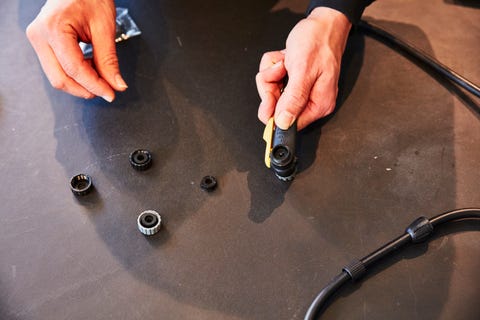
Trevor Raab
Depending on the kind of floor pump you have, you might be able to replace the entire pump head or the o-rings that go inside it that create a secure seal. Similarly, it's easy to install a new hose; you can often find either the replacement hose or both the hose and pump head together. To install both, simply unscrew the threaded cap at the end and pull the hose or head off the fitting.
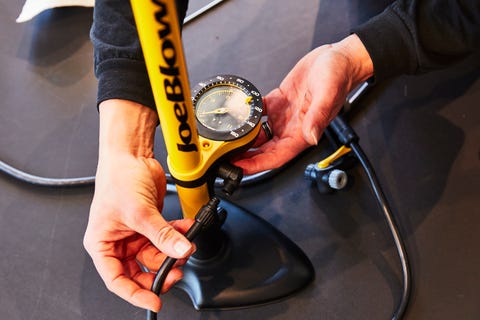
Trevor Raab
Main Seal
Like the many moving components on your bike, your floor pump parts also require periodic lubrication, specifically the main seal at the end of the plunger. "The main seal—also called the plunger [gasket] or main gasket—is essentially the seal that you are pushing down and pulling up to produce air," Nankman says.
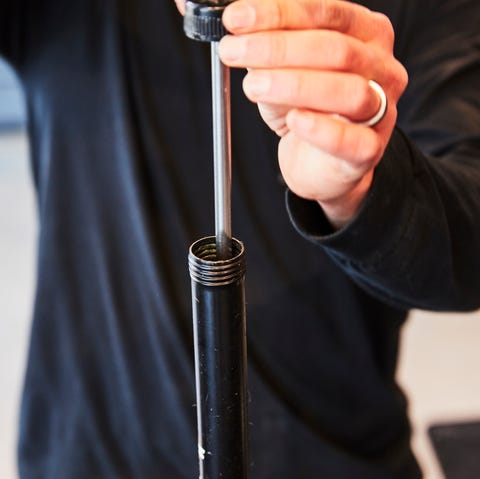
Trevor Raab
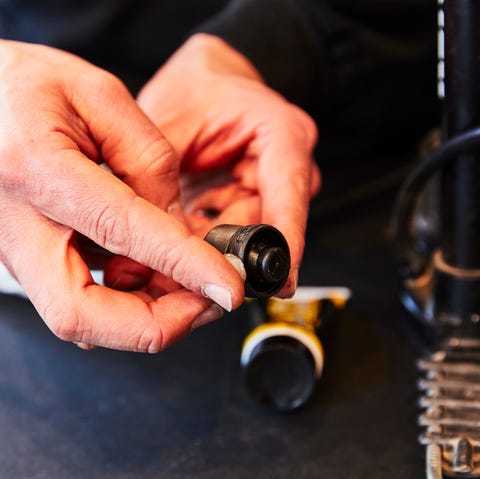
Trevor Raab
If the pumping action feels gritty, sounds noisy, or gives resistance, you likely need to lubricate the main seal. Nankman recommends doing it at least once a year, or more often if the pump is exposed to dry, dusty conditions. Standard bike grease will do the job, or you could use Nankman's go-to, WD-40 Specialist Silicone spray. But if your pump's plunger uses a leather gasket instead of a rubber one, you'll need a specific lubricant, like Silca's NFS Leather Conditioner.
Restore Your Floor Pump
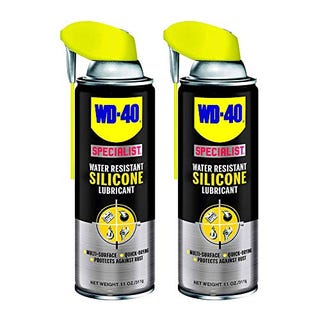
Specialist Water Resistant Silicone Lubricant Spray

NFS Leather Gasket Conditioner

Presta Valve Bike Tire Pressure Gauge

PPL-1 PolyLube 1000 Bicycle Grease
"If using grease, you need to take the top cap off the pump to expose the plunger. Pull the plunger out of the pump tube. Apply a little bit of grease to the plunger and reassemble," Nankman says. "If using a liquid silicone lubricant, [apply] a good spray on the pump shaft, and then pump up and down a few times to get the lube to get everywhere in the pump."
Pressure Gauge
Over time, your floor pump's pressure gauge can start to deteriorate, making it less accurate.
"Accuracy is the main [problem], but that is hard to quantify unless you get a new pump and compare it. I tend to recommend that people get a stand-alone pressure gauge anyway," Nankman says, which you can use to test the accuracy of your pump's pressure gauge. "They are inexpensive. I keep one in each vehicle, and a few around the house."
Follow the manufacturer's instructions on how to swap in a new gauge, though most are fairly straightforward; you'll remove the pressure gauge cover by either unscrewing it or prying it off.
So, Just How Long Can a Bike Pump Last?
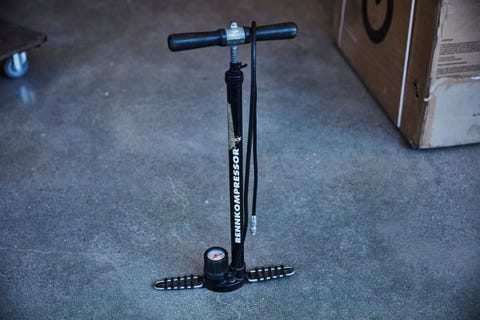
Trevor Raab
Well, that depends on the quality of its construction, how well you care for it, and the availability of replacement parts over time.
Nankman has his grandfather's German-made SKS RennKompressor floor pump—it's almost 50 years old and it still works (though he admits he uses it sparingly). "I have changed the head once and the leather seal a handful of times," he says.
4 Bike Pumps We Love

Vibrelli Bike Floor Pump
Vibrelli amazon.com
$34.99
Our favorite pump under $40.

Pedro's Prestige Floor Pump
Best for travel. Cheap, light, and reliable, with a very accurate gauge.

Air Handler Floor Pump
BIKETUBE BRAND amazon.com
$54.99
A good cheap and durable option.

Specialized Air Tool Comp V2 Floor Pump
Specialized jensonusa.com
$59.99
A dual-range guage that's for all tires.
Jessica Coulon Assistant Digital Editor When she's not out riding her mountain bike, Jessica reports on news, gear, and all things cycling related for Bicycling.
This content is created and maintained by a third party, and imported onto this page to help users provide their email addresses. You may be able to find more information about this and similar content at piano.io
How To Fix A Bike Pump Hose
Source: https://www.bicycling.com/repair/a35473934/how-to-repair-your-bike-floor-pump/
Posted by: lowthertrallese.blogspot.com

0 Response to "How To Fix A Bike Pump Hose"
Post a Comment